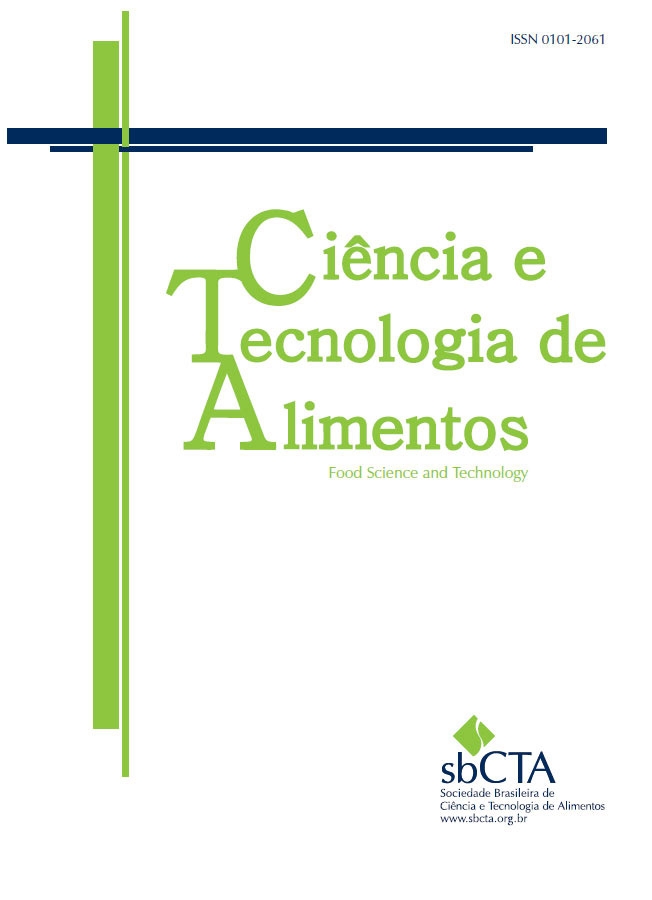Active film made from Psidium guajava peel and starch for use in food packaging
DOI:
https://doi.org/10.5327/fst.00409%20Keywords:
active films, flour of guava peel, antioxidant capacity, phenolic compoundsAbstract
The disposal of plastic film is a global problem that generates much pollution. The full use of waste from the food industry brings numerous benefits, including sustainable practices. Using films made with natural antioxidants derived from agro-industrial waste is considered an alternative to minimize these impacts. Given this context, this study aimed to develop and characterize films based on guava (Psidium guajava) peel flour for active food packaging. The films presented low thickness and solubility in water, proving to be a barrier to water vapor and suitable for maintaining the integrity of foods added to them. Moreover, their elasticity and resistance proved to be moderate and their moisture content is high due to the presence of large amounts of phenolic compounds from guava peel flour (320.58 ± 81.1 mg gallic acid/100 g sample), resulting in clear, slightly greenish-yellow films, which present their best effect as active antioxidant packaging to be applied in alcoholic foods (36 μmol Trolox/g), followed by use in acidic foods (17.2 μmol Trolox/g). This study demonstrated the potential for applying guava residue as a raw material for producing biodegradable films, proposing a purpose for the peel of this fruit.
Downloads
References
ASTM (2002). ASTM D 882–02: Método de teste padrão para propriedades de tração de chapas finas de plástico 374. ASTM Internacional.
ASTM (2005). ASTM E96/E 96M–05. ASTM.
Baur, F. J., & Ensminger, L. G. (1977). The Association of Official Analytical Chemists (AOAC). Journal of the American Oil Chemists’ Society, 54(4), 171-172. https://doi.org/10.1007/BF02670789
Benlloch-Tinoco, M., Gentile, P., Taylor, L., & Girón-Hernández, J. (2025). Alginate edible films as delivery systems for green tea polyphenols. Food Hydrocolloids, 158, 110518. https://doi.org/10.1016/j.foodhyd.2024.110518
Braga, M. A., Marques, T. R., Simão, A. A., Botelho, L. N. S., Oliveira, L. S., & Abreu, C. M. P. (2018). Mechanism of firmness loss in guava cv. Pedro Sato during ripening at room temperature. Food Science and Technology, 38(1), 26-32. https://doi.org/10.1590/1678-457X.35416
Brasil (2010). Agência Nacional de Vigilância Sanitária. Resolução de Diretoria Colegiada – RDC n° 51, de 26 de novembro de 2010. Agência Nacional de Vigilância Sanitária.
Danielski, R., & Shahidi, F. (2023). Guava processing waste: Biological activity profile of a natural and sustainable source of phenolic antioxidants. Food Bioscience, 56, 103294. https://doi.org/10.1016/J.FBIO.2023.103294
de Faria Cardoso, C. E., Trindade, M. E. F., Santana, M. G., Lobo, F. A. T. F., & Teodoro, A. J. (2023). Improvement of the phenolic composition and the antioxidant capacity of red guava (Psidium guajava) and watermelon (Citrullus lanatus) powders by means of foam blanket drying. Food Chemistry Advances, 3, 100368. https://doi.org/10.1016/J.FOCHA.2023.100368
Díaz, O., Ferreiro, T., Rodríguez-Otero, J. L., & Cobos, Á. (2019). Characterization of chickpea (Cicer arietinum L.) flour films: effects of pH and plasticizer concentration. International Journal of Molecular Sciences, 20(5), 1246. https://doi.org/10.3390/IJMS20051246
Gontard, N., Guilbert, S., & Cuq, J. ‐L. (1992). Edible wheat gluten films: influence of the main process variables on film properties using response surface methodology. Journal of Food Science, 57(1), 190-195. https://doi.org/10.1111/J.1365-2621.1992.TB05453.X
Hiremani, V. D., Sataraddi, S., Bayannavar, P. K., Gasti, T., Masti, S. P., Kamble, R. R., & Chougale, R. B. (2020). Mechanical, optical and antioxidant properties of 7-Hydroxy-4-methyl coumarin doped polyvinyl alcohol/oxidized maize starch blend films. SN Applied Sciences, 2(11), 1-18. https://doi.org/10.1007/s42452-020-03399-2
Instituto Brasileiro de Geografia e Estatística (IBGE) (2024). Brazilian guava production. IBGE. Retrieved from https://www.ibge.gov.br/explica/producao-agropecuaria/goiaba/br
Jorge, A. M. S., Gaspar, M. C., Henriques, M. H. F., & Braga, M. E. M. (2023). Edible films produced from agrifood by-products and wastes. Innovative Food Science and Emerging Technologies, 88, 103442. https://doi.org/10.1016/j.ifset.2023.103442
Kumar, M., Kapoar, S., Dhumal, S., Tkaczewska, J., Changan, S., Saurabh, V., Mekhemar, M., Radha, Rais, N., Satankar, V., Pandiselvam, R., Sayed, A. A. S., Senapathy, M., Anitha, T., Singh, S., Tomar, M., Dey, A., Zengin, G., Amarowicz, R., & Bhuya, D. J. (2022). Guava (Psidium guajava L.) seed: A low-volume, high-value byproduct for human health and the food industry. Food Chemistry, 386, 132694. https://doi.org/10.1016/j.foodchem.2022.132694
Lalnunthari, C., Devi, L. M., Amami, E., & Badwaik, L. S. (2019). Valorisation of pumpkin seeds and peels into biodegradable packaging films. Food and Bioproducts Processing, 118, 58-66. https://doi.org/10.1016/J.FBP.2019.08.015
Re, R., Pellegrini, N., Proteggente, A., Pannala, A., Yang, M., & Rice-Evans, C. (1999). Antioxidant activity applying an improved ABTS radical cation decolorization assay. Free Radical Biology and Medicine, 26(9-10), 1231-1237. https://doi.org/10.1016/S0891-5849(98)00315-3
Ribeiro Sanches, M. A., Camelo-Silva, C., Silva Carvalho, C., Rafael de Mello, J., Barroso, N. G., Lopes da Silva Barros, E., Silva, P. P., & Pertuzatti, P. B. (2021a). Active packaging with starch, red cabbage extract and sweet whey: Characterization and application in meat. LWT, 135, 110275. https://doi.org/10.1016/J.LWT.2020.110275
Ribeiro Sanches, M. A., Camelo-Silva, C., Tussolini, L., Tussolini, M., Zambiazi, R. C., & Becker Pertuzatti, P. (2021b). Development, characterization and optimization of biopolymers films based on starch and flour from jabuticaba (Myrciaria cauliflora) peel. Food Chemistry, 343, 128430. https://doi.org/10.1016/J.FOODCHEM.2020.128430
Rodrigues, A. A. M., da COSTA, R. R., Dos Santos, L. F., Silva, S. de M., de Britto, D., & de Lima, M. A. C. (2021). Properties and characterization of biodegradable films obtained from different starch sources. Food Science and Technology, 41(Suppl. 2), 476-482. https://doi.org/10.1590/FST.28520
Shanbhag, C., Shenoy, R., Shetty, P., Srinivasulu, M., & Nayak, R. (2023). Formulation and characterization of starch-based novel biodegradable edible films for food packaging. Journal of Food Science and Technology, 60(11), 2858-2867. https://doi.org/10.1007/s13197-023-05803-2
Singleton, V. L., Orthofer, R., & Lamuela-Raventós, R. M. (1999). Analysis of total phenols and other oxidation substrates and antioxidants by means of folin-ciocalteu reagent. Methods in Enzymology, 299, 152-178. https://doi.org/10.1016/S0076-6879(99)99017-1
Vinhal, G. L. R. R. B., Silva-Pereira, M. C., Teixeira, J. A., Barcia, M. T., Pertuzatti, P. B., & Stefani, R. (2020). Gelatine/PVA copolymer film incorporated with quercetin as a prototype to active antioxidant packaging. Journal of Food Science and Technology, 58, 3924-3932. https://doi.org/10.1007/s13197-020-04853-0



